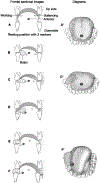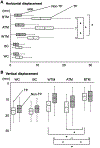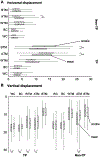Kinematics of lateral tongue-pushing movement in coordination with masticatory jaw movement: An anteroposterior projection videofluorographic study
- PMID: 37536619
- PMCID: PMC10530480
- DOI: 10.1016/j.physbeh.2023.114315
Kinematics of lateral tongue-pushing movement in coordination with masticatory jaw movement: An anteroposterior projection videofluorographic study
Abstract
Objective: During the mastication of solid food, the tongue pushes the bolus laterally to place it onto occlusal surfaces as the jaw is opened. This movement is referred to as tongue-pushing (TP). TP has an important role in efficient chewing, but its kinematic mechanisms remain unclear. The present study quantified the kinematics of TP and its coordination with masticatory jaw movements.
Methods: Videofluorography (VFG) in anteroposterior projection was recorded while 14 healthy young adults ate 6 g each of cookies and meat. Small lead markers were glued to the tongue surface (left, right, and anterior) and buccal tooth surfaces (upper molars and lower canines). The position of the tongue and lower canine markers relative to the upper occlusal plane was quantified with Cartesian coordinates, using the right upper molar as the origin. Jaw motion during chewing was divided into TP and Non-TP cycles, based on the lateral movement of the food and tongue markers. The side of the jaw that compressed food particles was defined as the working side, while the other side was termed the balancing side. Horizontal and vertical displacements of tongue and jaw markers were compared between TP and Non-TP cycles, as well as between food types.
Results: The mediolateral displacement of all tongue markers was significantly larger in TP than in Non-TP cycles. Vertical displacement was also significantly greater in TP than in Non-TP cycles for the anterior and working side tongue markers. TP cycles occurred more frequently with meat-chewing than with cookie-chewing.
Conclusion: TP is accomplished by rotation and lateral movements of the tongue surface on the working side and the anterior tongue blade, along with medial movement on the balancing side. These movements produce lateral shift and rotation of the tongue surface toward the working side in concert with jaw opening. Designing exercises to improve the strength of the lateral motion and rotation of the tongue body may be useful for individuals with impaired tongue function for eating and swallowing.
Keywords: Cookie; Mastication; Meat; Occlusal surfaces; Radiopaque markers; Tongue pushing.
Copyright © 2023. Published by Elsevier Inc.
Conflict of interest statement
Declarations of Competing Interest None.
Figures








Similar articles
-
A postero-anterior videofluorographic study of the intra-oral management of food in man.Arch Oral Biol. 2002 Apr;47(4):267-80. doi: 10.1016/s0003-9969(02)00007-9. Arch Oral Biol. 2002. PMID: 11922870
-
Fluoroscopic evaluation of tongue and jaw movements during mastication in healthy humans.Dysphagia. 2013 Sep;28(3):419-27. doi: 10.1007/s00455-013-9453-1. Epub 2013 Feb 28. Dysphagia. 2013. PMID: 23446812
-
Patterns of tongue and jaw movement in a cinefluorographic study of feeding in the macaque.Arch Oral Biol. 1995 Mar;40(3):229-46. doi: 10.1016/0003-9969(95)98812-d. Arch Oral Biol. 1995. PMID: 7605250
-
Mastication and swallowing: an overview.Br Dent J. 1992 Oct 10;173(6):197-206. doi: 10.1038/sj.bdj.4808002. Br Dent J. 1992. PMID: 1389633 Review.
-
Oral physiology and mastication.Physiol Behav. 2006 Aug 30;89(1):22-7. doi: 10.1016/j.physbeh.2006.01.025. Epub 2006 Mar 29. Physiol Behav. 2006. PMID: 16564557 Review.
Cited by
-
Tongue and jaw movement assessed by 3D motion capture during gum chewing.Front Physiol. 2024 Aug 28;15:1409005. doi: 10.3389/fphys.2024.1409005. eCollection 2024. Front Physiol. 2024. PMID: 39263626 Free PMC article.
References
Publication types
MeSH terms
Grants and funding
LinkOut - more resources
Full Text Sources
Research Materials

